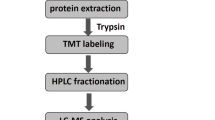Abstract
In order to understand the allograft rejection in orthotopic liver transplantation (OLT), an allograft rejection rat model was established and studied by proteomic approach. The protein expression profiles of liver tissues were acquired by fluorescence two-dimensional difference gel electrophoresis (2D DIGE) that incorporated a pooled internal standard and reverse fluorescent labeling method. The expression levels of 27 protein spots showed significant changes in acute rejection rats. Among these spots, 19 were identified with peptide mass fingerprinting using matrix-assisted laser desorption ionization time of flight mass spectrometry (MALDI-TOF MS) after tryptic in-gel digestion. The results of the present paper could be helpful for our better understanding of allograft rejection in organ transplantation.
Similar content being viewed by others
Abbreviations
- Cy2:
-
3-[(4-carboxymethyl)-phenylmethyl]-3′-ethyloxacarbocyanine halide N-hydroxysuccinimidyl ester
- Cy3:
-
1-(5-carboxypentyl)-1′-propylindocarbocyanine halide N-hydroxysuccinimidyl ester
- Cy5:
-
1-(5-carboxypentyl)-1′-methylindodicarbo-cyanine halide N-hydroxysuccinimidyl ester
- OLT:
-
orthotopic liver transplantation
- ACN:
-
acetonitrile
- TFA:
-
trifluroracetic acid
References
Curry M P. Hepatitis B and hepatitis C viruses in liver transplantation. Transplantation, 2004, 78(7): 955–963
Anantharaju A, Van Thiel D H. Liver transplantation for alcoholic liver disease. Alcohol Res Health, 2003, 27(3): 257–268
Wong L L. Current status of liver transplantation for hepatocellular cancer. Am J Surg, 2002, 183(3): 309–316
Frilling A, Malago M, Broelsch C E. Current status of liver trans-plantation for treatment of hepatocellular carcinoma. Dig Dis, 2001, 19(4): 333–337
Saadeh S, Davis G L. Management of ascites in patients with end-stage liver disease. Rev Gastroenterol Disord, 2004, 4(4): 175–185
Gomez-Manero N, Herrero J I, Quiroga J, et al. Prognostic model for early acute rejection after liver transplantation. Liver Transplant, 2001, 7(3): 246–254
Neuberger J. Incidence, timing, and risk factors for acute and chronic rejection. Liver Transplant Surg, 1999, 5(4): S30–36
Janssen H, Lange R, Erhard J, et al. Serum bile acids in liver trans-plantation-early indicator for acute rejection and monitor for antire-jection therapy. Transplant Int, 2001, 14(6): 429–437
Zhou G, Li H, DeCamp D, et al. 2D differential in-gel electrophoresis for the identification of esophageal scans cell cancer-specific protein markers. Mol Cell Proteomics, 2002, 1(2): 117–124
Seike M, Kondo T, Fujii K, et al. Proteomic signature of human cancer cells. Proteomics, 2004, 4(9): 2776–2788
Wishart D S. Metabolomics: the principles and potential applications to transplantation. Am J Transplant, 2005, 5(12): 2814–2820
Pan T L, Wang P W, Huang C C, et al. Expression, by functional proteomics, of spontaneous tolerance in rat orthotopic liver trans-plantation. Immunology, 2004, 113(1): 57–64
Pan T L, Goto S, Lord R, et al. Proteome analysis in liver transplantation. Transplant Proc, 2001, 33(1–2): 156
Clarke W, Silverman B C, Zhang Z, et al. Characterization of renal allograft rejection by urinary proteomic analysis. Ann Surg, 2003, 237(5): 660–665
Kamada N, Calne R Y. A surgical experience with five hundred and thirty liver transplants in the rat. Surgery, 1983, 93: 64–69
Alban A, David S O, Bjorkesten L, et al. A novel experimental design for comparative two-dimensional gel analysis: Two-dimensional difference gel electrophoresis incorporating a pooled internal standard. Proteomics, 2003, 3(1): 36–44
Yan J X, Wait R, Berkelman T, et al. A modified silver staining protocol for visualization of proteins compatible with matrix-assisted laser desorption/ionization and electrospray ionization-mass spectrometry. Electrophoresis, 2000, 21(17): 3666–3672
Zhang C, Wei J, Zheng Z, et al. Proteomic analysis of Deinococcus radiodurans recovering from gamma-irradiation. Proteomics, 2005, 5(1): 138–143
Le Moine A, Goldman M, Abramowicz D. Multiple pathways to allograft rejection. Transplantation, 2002, 73(9): 1373–1381
Rogers L A, Zlotnik A, Lee F, et al. The maintenance of lytic specificity during the development of clones of cytotoxic T lymphocytes from single precursor cells. J Immunol Methods, 1991, 143(2): 241–250
Kaminski E R, Kaminski A, Bending M R, et al. In vitro cytokine profiles and their relevance to rejection following renal transplantation. Transplantation, 1995, 60(7): 703–706
Bosron W F, Li T K. Genetic polymorphism of human liver alcohol and aldehyde dehydrogenases and their relationship to alcohol metabolism and alcoholism. Hepatology, 1986, 6(3): 502–510
Yokoyama A, Kato H, Yokoyama T, et al. Genetic polymorphisms of alcohol and aldehyde dehydrogenases and glutathione S-transferase M1 and drinking, smoking, and diet in Japanese men with esophageal squamous cell carcinoma. Carcinogenesis, 2002, 23(11): 1851–1859
Li J, Li Q, Xie C, et al. β-actin is required for mitochondria clustering and ROS generation in TNF-induced, caspase-independent cell death. J Cell Sci, 2004, 117(20): 4673–4680
Author information
Authors and Affiliations
Corresponding author
Additional information
These authors contributed equally to this work
Supported by the Key Basic Research and Development Program of China (Grant No. 2003CB515506), and in part by the Chinese Human Liver Proteome Project (CNHLPP) (Grant No. 2004BA711A18)
Rights and permissions
About this article
Cite this article
Zhang, C., Zhu, F., Wei, J. et al. A proteomic analysis of allograft rejection in rats after liver transplantation. SCI CHINA SER C 50, 312–319 (2007). https://doi.org/10.1007/s11427-007-0038-9
Received:
Accepted:
Issue Date:
DOI: https://doi.org/10.1007/s11427-007-0038-9




